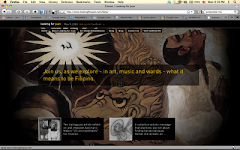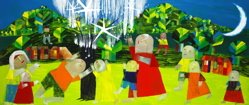It's hard to fathom that it's been 22 years. A whole generation of the young don't even have a clue of how powerful that singular moment was, when the Philippines seemed so full of hope and promise.
We may be in the minority right now (we're not sure), but despite all that has happened since, and is happening now, we believe that hope remains this country's great unifier, and is one of the most important things that define what it means to be Filipino.
So, we still think this day is worth remembering... and celebrating...
Monday, February 25, 2008
Thursday, February 14, 2008
Performance Art
We should have stuff like this going on here.
Click here to see more "scenes of chaos and joy in public spaces."
Click here to see more "scenes of chaos and joy in public spaces."
An Overseas Lechon Story

Here's a great story written by Vikki Ortiz for the Chicago Tribune that we found through Pinoycentric.
Roast Pig Provides Filipinos in Chicago with a Taste of Home
The temperatures were the coldest in a year and the windchill factor was 20 degrees below zero, but Amante Enad stood in the back yard of his Wheeling home roasting pigs -- seven of them -- over a charcoal fire.
"It doesn't matter how cold it is," Enad said last week as he held his hands over a sizzling 50-pounder to avoid frostbite. "I will do it."
Enad, 55, may live thousands of miles from the Philippines, where he first learned to prepare lechon -- roast pork -- but he and other Filipinos who have settled in the Chicago area continue the beloved tradition. Lechoneras hustle to serve the Midwest's largest Filipino population, and it's become more than a lucrative side business for factory workers, engineers, retirees and others who picked up the skill and now get as many as 100 calls a month for orders.
It's also a way for many to remember where they came from.
"Some people, they get homesick," said MarieBelle Concepcion of Carol Stream. "But if they see [lechon] there, they don't need to think about home."
Filipinos now comprise the third-largest group of Asians living in Cook County behind Indians and Chinese. According to a 2006 Census Bureau report, an estimated 59,186 Filipinos live in the county.
In the Philippines, a large gathering isn't complete without a full-size roast pig gracing the dining table. Filipinos mark every major occasion with lechon -- from christenings, weddings and funerals to holidays. Like turkey at Thanksgiving dinners, lechon is associated with celebration and family, said Berth Salvador, cultural officer for the Philippine Consulate General in Chicago.
The pig is speared lengthwise and roasted over an open fire until the skin is brown and crunchy. Seasoning varies depending on the region of the Philippines where the chef hails from -- simple salt and pepper with liver sauce in some areas; onion, garlic and lemon grass for others.
The entire animal is cooked -- head, tail, ears, eyes and legs. Special side dishes are made from the heart, intestines, kidneys and even blood.
"The tradition of the Philippines will live, even if we are not in the Philippines," Salvador said.
Luna Cudiamat, 48, of Bloomingdale rubs vegetable oil on the pigs to enhance natural flavors when he prepares anywhere from 6 to 10 lechones each weekend at a trailer in a vacant lot in Addison. Cudiamat supplies the delicacy to a handful of Filipino restaurants in the Chicago area. Many chefs rely on lechoneras to prepare the dish, which would be difficult to make in commercial kitchens.
Aling Tining, 70, of Forest Park learned to make lechon as a young girl, listening to her grandmother give cooking instructions at her childhood home on the island of Cebu. A few years after moving to the United States in 1984, Tining asked her husband, an engineer, to design a motorized half-barrel roasting oven so she could cook lechon in their back yard.
Today, Tining and her husband prepare lechon -- which sells for at least $150 each -- for word-of-mouth customers. She prides herself on sticking to the Cebu-style recipe, stuffing the pig with onions, lemon grass and garlic before cooking it outside for four hours at a stretch, even during the winter.
"That's why you have to bundle," she said. "Long johns, three pants, sweater and then sweat shirt, and then hats -- three."
Back-yard pig-roasting can raise the eyebrows of neighbors, prompting some to do the cooking by stealth. But sometimes, the smell of pig on a cold January morning also helps the cooks and their neighbors bond.
Enad has been known to drop plates of lechon off at his next-door neighbor's house and a nearby bank.
"They eat it," he said. "They like it."
Pork dishes are especially popular in the Philippines, where cuisine is influenced by Chinese and Spanish cooking, because the meat is easily accessible to everyday citizens, said Amy Besa, co-author of "Memories of Philippine Kitchens: Stories and Recipes From Far and Near."
Besa said an interesting paradox is created as Filipino-Americans work hard to replicate treasured dishes. While the Philippines becomes more Americanized with international fast-food chains, packaged mixes and products, Filipino-Americans maintain the home country's true flavor.
"The moment you become an expatriate, the more your foods from home become very dominant in your desires. You really long for them. You become nostalgic for them," Besa said. "People who move here ... they're the ones who preserve those foods from a different generation."
Enad, who has roasted as many as 30 pigs in one day in his back yard, recently donated his services for a Filipino fiesta held at St. Catherine Laboure Catholic Church in Glenview.
The payoff came when attendees such as Nina Torres, 56, of Carol Stream dug into a plate. Torres said just seeing lechon on the table brought back memories of her childhood. She remembered standing in the back yard with family, enjoying the spectacle and smelling the sweet aroma.
"It's like we're all together watching," Torres said. "It's like we're all back home."
Photo: “And save us from cholesterol..” by A. B. Frasco ©2007 All rights reserved. Through Ambibo.
Thursday, February 7, 2008
Lascano's Waterfalls
 Rico Lascano presents his latest abtracts in "Waterfall" at 1/of Gallery, 2nd level, Shops at Serendra, Bonifacio Global City, Taguig.
Rico Lascano presents his latest abtracts in "Waterfall" at 1/of Gallery, 2nd level, Shops at Serendra, Bonifacio Global City, Taguig. Lascano has been unveiling a sequence of solo exhibitions that are all inter-related by the water-image. In his quietly still canvases murmur the ripples of brooks, streams and rivers, through a web of lines and an exhalation of open space envisioned in a meditative level. Indeed, his paintings are an immersion in Zen aesthetics. Water, regarded by oriental philosophers as the "blood of nature," courses through Lascano's art as a life-giving force. This exhibition is the artist's continuing dialogue with this most refreshing-and-threatening element.
"Waterfall" opens on Friday, February 8, 2008 at 6pm. Call 901-3152 for details.
*** 1/of Gallery is an alternative art space for emerging Filipino artists, and is majority-owned by CANVAS.
Taking a Stand
You can really count on this government to provide us with non-stop entertainment… except that this latest episode is not funny and must only be seen as a cause for just and moral outrage.
After JDV’s rambling and hypocritical valedictory and political assassination in Congress a few days ago, we now have the riveting fiasco over Jun Lozada and the ZTE scandal that just won’t die.
The brazenness of how Lozada was taken from the airport is stunning, but the inconsistent and illogical version that the government now seeks us to believe – that the Lozadas had asked for protection (then why the emotional and inconsolable plea from his wife for his safe return) – is even more brazen and stunning.
We’ve been listening to the press conference at La Salle, and Jun Lozada seems to us to be a decent man. That such a man can suddenly disappear from the airport, just after his plane landed, in the full glare of daylight, with no less than his family, members of media and even some Senators waiting in the airport’s lounge, is horrifyingly incredible.
And while for now Lozada has emerged alive, if not necessarily unscathed, who knows now what sword hangs over his head as he prepares to testify before the Senate.
Whatever happens, one thing is sure. His very public ordeal has now likely created a chilling effect on freedom of expression, and equally important, on the incentives for decent people like Lozada to pursue public service.
We will not stand for it.
We don’t know yet how exactly CANVAS can meaningfully join the discourse but today – even as we remain a nonpartisan nonprofit – we make our commitment to develop programs that will explore and encourage the participation of the arts in ensuring that the space for free expression and public service is protected and expanded.
After JDV’s rambling and hypocritical valedictory and political assassination in Congress a few days ago, we now have the riveting fiasco over Jun Lozada and the ZTE scandal that just won’t die.
The brazenness of how Lozada was taken from the airport is stunning, but the inconsistent and illogical version that the government now seeks us to believe – that the Lozadas had asked for protection (then why the emotional and inconsolable plea from his wife for his safe return) – is even more brazen and stunning.
We’ve been listening to the press conference at La Salle, and Jun Lozada seems to us to be a decent man. That such a man can suddenly disappear from the airport, just after his plane landed, in the full glare of daylight, with no less than his family, members of media and even some Senators waiting in the airport’s lounge, is horrifyingly incredible.
And while for now Lozada has emerged alive, if not necessarily unscathed, who knows now what sword hangs over his head as he prepares to testify before the Senate.
Whatever happens, one thing is sure. His very public ordeal has now likely created a chilling effect on freedom of expression, and equally important, on the incentives for decent people like Lozada to pursue public service.
We will not stand for it.
We don’t know yet how exactly CANVAS can meaningfully join the discourse but today – even as we remain a nonpartisan nonprofit – we make our commitment to develop programs that will explore and encourage the participation of the arts in ensuring that the space for free expression and public service is protected and expanded.
Saturday, February 2, 2008
CANVAS Projects for 2008 in a Nutshell
 Here's a rundown of our upcoming projects, in case you want to keep track.
Here's a rundown of our upcoming projects, in case you want to keep track.The next big show is Si Lupito at ang Barangay Sirkero, based on the winning story of CANVAS' 3rd Annual Romeo Forbes Children's Storywriting Competition, written by Rowald Almazar, with paintings by Jose Santos III.
October 2008 will see something different - Looking for Juan - an art and music extravaganza featuring new original paintings and songs by some of the best young artists and rock bands, all exploring What It Means to Be Filipino. We're partnering with Songstream Studios, and we have an impressive line-up:
* Plet Bolipata : Cynthia Alexander
* Elmer Borlongan : Dong Abay
* Fred Esquillo : Loquy
* Karen Flores : Drip
* Manny Garibay : Noel Cabangon
* Winner Jumalon : Up Dharma Down
* Mark Justiniani : Joey Ayala
We have three more full-color books set to be published this year:
* Crux, which we recently showcased at the Ayala Museum featuring Manny Garibay's paintings and Gelo Suarez' poetry.

* Message in the Sand, an environmental children's story, especially written for CANVAS by a Charmaine Aserappa, a UK writer and international bestseller. How we got this story commissioned is a story in itself that we will share in a future entry. :-) Roel Obemio (two of his studies for the story are shown in this post) will be our artist for this project.
* A trilogy of short ecofables featuring the art of Plet Bolipata (The Hummingbird), Ivee Olivares-Mellor (The King and the Royal Trees), and Liza Flores (The Star Thrower), which will be launched in December.
Then, of course, we have our two ongoing competitions: The 2008 Romeo Forbes Children's Storywriting Competition, and the Oblation Nation Art Competition.
And finally, there's CANVAS Downstream, our continuing experiment with e-commerce, an existing and soon to be growing presence on Amazon.com, as well as our line-up of exhibitions for 1/of Gallery, which we are finalizing and will also post shortly.
It's going to be a busy, busy and extremely fun year. We really hope you all continue to join us for the ride. :-)
Subscribe to:
Posts (Atom)




